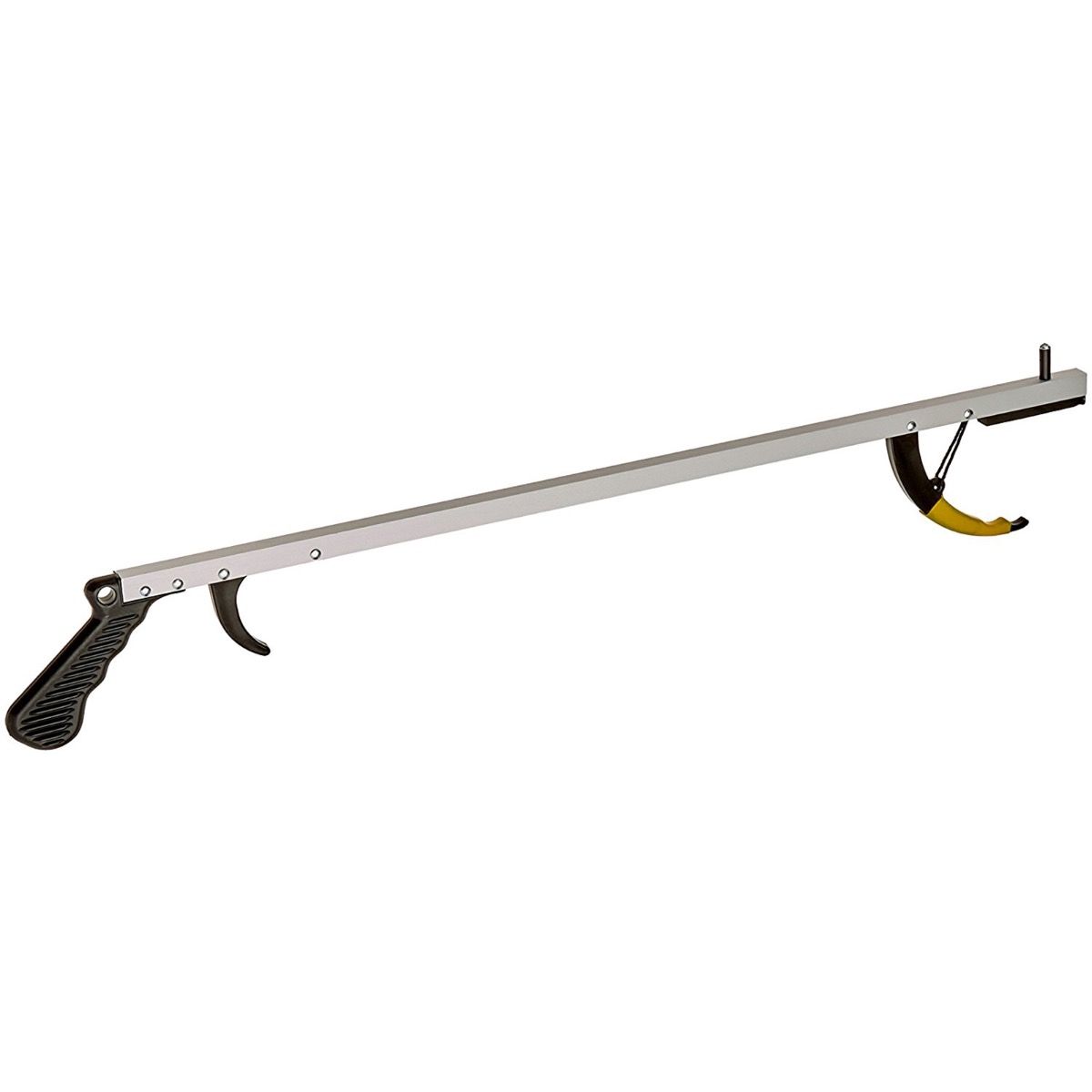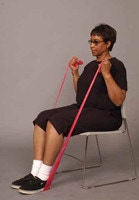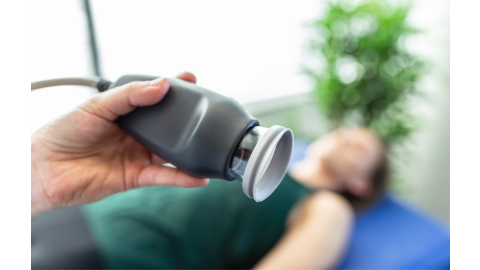Has your doctor suggested a hip replacement to relieve your hip pain? Or maybe you already have a hip replacement surgery scheduled?
Doing exercises before your hip replacement surgery can help you get ready and improve your outcome during recovery, thanks to your increased strength. You might even reduce your odds of needing inpatient rehab. So what are you waiting for? Start working out now!
- What is a hip replacement and why do people get them?
- Hip Replacement Surgery and COVID-19
- What You Should Know & Buy Before Hip Replacement Surgery
- Why Should You Exercise Before Hip Replacement Surgery?
- Get Started With a 13 Exercise Prehab Workout Before Your Hip Replacement
- 5 Hip Pain Relief Suggestions
- Bonus: 6 Rehabilitation Exercises After Your Hip Replacement
|
|
What is a hip replacement and why do people get them?
A hip replacement is a surgical procedure that removes damaged sections of the hip joint (bone and cartilage) and replaces them with a replacement hip joint and socket made of metal, ceramic, or hard plastic.1
The most common reason for a hip replacement is osteoarthritis, which damages the cartilage that covers the ends of the joint, enabling smooth movement.1
Hip replacement surgery is typically considered when a person has hip pain that interferes with daily activities and when nonsurgical treatments are no longer effective or have not helped.1
Hip Replacement Surgery and COVID-19

During the Coronavirus-19 pandemic, many elective surgeries are being postponed, including hip and knee replacements.
One study estimates that 30,000 primary and 3000 revision hip and knee replacement surgeries will be canceled each week while COVID-19 restrictions regarding non essential surgery are in place.2
Of course, if you’re the one getting a hip replacement it may not feel “elective”. Dr. Christopher Smith, orthopedic surgeon at Houston Methodist West Hospital acknowledges, “It's the kind of pain that leads [people] to become less active, whether athletically or socially, and many people get to the point where the pain becomes such a big part of their lives they become unhappy...during [our one year follow up] visit, I commonly hear, 'I wish I had done this sooner. There's not necessarily a medical rush to have a joint replaced. However, the decision to proceed with joint replacement — sooner than later — will eliminate the pain and suffering of a prolonged waiting period.”3
If you’re stuck waiting for your hip replacement surgery, there are still steps you can take to prepare, so you’re ready once your surgery is rescheduled!
What You Should Know & Buy Before Hip Replacement Surgery

Getting ready for your hip replacement? Learn about how a hip replacement is performed, including two ways the replacement can be attached to the bone. And find out our top suggestions for helpful tools as you recover, including a reacher, a raised toilet seat, and more. Plus, find out what happens after surgery. Get the answers by reading this article, What You Need to Know (and Buy) Before a Hip Replacement!
Why Should You Exercise Before Hip Replacement Surgery?
Have you heard the term “prehab”? “Pre” means before and “hab” refers to rehabilitation. Prehab includes things like nutrition and workouts. Prehab exercises are done before surgery to help improve your outcome after surgery by strengthening the muscles you’ll be using and working during recovery.
In fact, studies have shown that hip and knee replacement patients who participated in prehab reduced their need for inpatient care after surgery by up to 73%.5 The increased strength makes it easier to start walking and getting in and out of bed soon after surgery. Physical therapist Steve Sylvester says that “Patients who are more fit prior to surgery may have shorter hospital stays and fewer outpatient rehab sessions”. 5
So start your hip replacement prehab now!
Get Started With a 13 Exercise Prehab Workout Before Your Hip Replacement

You should always talk to your doctor, physical therapist, or other healthcare professional before beginning a new exercise program.
Do not complete any of these exercises if they cause you pain. Your muscles might be sore after exercising, but you should not be in pain while exercising.
Ready to get started? Follow these prehab exercises to prepare for your hip replacement surgery.
- 3 Upper Extremity Exercises: Strengthen Your Arms Before Using Crutches or a Walker
- 10 Lower Extremity Exercises: Strengthen Your Hip Before Surgery
3 Upper Extremity Exercises: Strengthen Your Arms Before Using Crutches or a Walker
After your hip replacement surgery, you will probably spend some time on crutches or using a walker while you recover. Both of these mobility aids require some upper arm strength. Get your arms in shape before surgery with these exercises!
Bicep Curls


Standing
- Stand with your feet hip-width apart on the TheraBand CLX band and hold one end loop in each hand
- Lower your arm to a starting position and then bring your hands up to your shoulders by bending your elbows, keeping your upper arms by your sides
- Hold, return to starting position, and repeat for 10 repetitions
Sitting
- Sit in a sturdy chair with the CLX band under your feet and one end loop in each hand
- Lower your arm to a starting position and then bring your hands up to your shoulders by bending your elbows, keeping your upper arms by your sides
- Hold, return to starting position, and repeat for 10 repetitions
To make this exercise more challenging, move both hands down a loop to create more resistance.
Elbow Extensions

- Sit in a stable chair
- Stabilize your resistance band by holding one end in your hand with the arm extended (the left arm in the photo above)
- Grasp the other end of the band in your other hand with your elbow bent (the right arm in the photo above)
- Straighten your arm, pulling the band back while holding steadily with the other hand
- Hold, return to starting position and repeat
- After 10 repetitions, repeat on the other arm
Seated Chair Press Ups
- Sit down in a sturdy chair with sturdy armrests and no wheels, sitting towards the front of the chair
- Place your palms flat on the armrest and press down to lift your butt off the chair
- Hold for a few seconds and then bend your elbows to slowly lower yourself back down
- Repeat for 10 repetitions
10 Lower Extremity Exercises: Strengthen Your Hip Before Surgery
Try these simple exercises to get your hips and legs in shape before your hip replacement surgery. Follow the steps below or watch the video to get started!
Aim for 10 repetitions for each exercise below.
Ankle Pumps
- Lay down on your back on your bed
- Bring your toes up towards the ceiling, flexing your foot
- Bring your toes down towards the floor, like you’re pressing on a gas pedal
- Repeat at a nice, quick pace
Quad Sets
- Lay down on your back on your bed
- Place a rolled towel under your knee
- Push down into the towel roll, tightening up your quads (thigh muscles)
- Hold for five seconds
- Relax and repeat
- Switch to the opposite leg and repeat the exercise
Gluteal Sets
- Lay down on your back on your bed
- Tightly squeeze your glutes
- Hold for five seconds (if you do this on a firm surface (like the floor or a table) you should see the hips come slightly up off the surface)
- Relax and repeat
Heel Slides
- Lay down on your back on your bed
- Slide your heel up towards your glutes as far as you feel comfortable, bending your knee
- Hold for 5 seconds
- Slide your heel back down to your starting position
- Repeat
- Switch to the opposite leg and repeat
If there is too much resistance, place a sheet of plastic, a piece of cardboard, or a cookie sheet down to lower the resistance.
Long Arc Quads
- Sit in a chair with your knees back towards the edge of the chair as much as possible
- Sit with good posture, sitting up straight with your chest out and shoulders back
- Extend one leg straight out towards the ceiling, keeping your foot relaxed
- Hold for five seconds and then return to your starting position
- Repeat
- Switch legs and repeat
Seated Hamstring Stretch
- Sit on a sturdy chair
- Place one foot up on a small stool or box, with the knee fully extended
- Sit up with good posture
- Lean forward hinging at the hips
- When it starts to pull at your hamstrings (the back of your leg), hold for 20-30 seconds
- Relax and repeat
- Switch to the opposite leg and repeat
Bridge
- Lay down on your back on your bed
- Bring both feet up towards your glutes, so your knees are bent at about 90 degrees
- Keep your feet shoulder-width apart
- Place your hands in one of three positions:
- Easiest: Arms flat down at your sides
- Medium: Elbows bent so your hands are up in the air
- Hardest: Cross your arms over your chest
- Tighten your core, lift your hips toward the ceiling, and squeeze your glutes
- Hold for 5 seconds
- Relax and repeat
Bridge Extension
- Lay down on your back on your bed
- Bring both feet up towards your glutes, so your knees are bent at about 90 degrees
- Keep your feet shoulder-width apart
- Place your arms flat down at your sides
- Tighten your core, lift your hips toward the ceiling, and squeeze your glutes
- Kick your non-surgical leg outward extending it
- Hold for five seconds
- Relax and repeat
Standing Hip Abduction
- Stand next to a sturdy object, like a countertop, table, or dresser for support
- Place your hands flat on top of the sturdy object
- Lift your surgical leg out to the side
- Hold, return, and repeat
- Keep your hips level during this exercise
Side Lying Leg Lift
- Lay on your side (the non-surgical side) on your bed
- Rest your top arm on your side so you create a straight line from your shoulder to your hip to your legs
- Bend your bottom, non-surgical leg if you need extra support
- Tighten your core and thigh muscles and lift your top leg up towards the ceiling
- Keep your toes pointing forward or down (not towards the ceiling)
- Keep your hip rolled forwards, not backwards
- Hold and repeat
5 Hip Pain Relief Suggestions



As you wait for your hip replacement, talk to your doctor about ways to temporarily relieve your pain. This may include:
- Medication
- Corticosteroid Injections
- Using a Mobility Aid
- Reusable Hot and Cold Packs
- Biofreeze
Pain relieving medications, including anti-inflammatories, may help reduce your hip pain. Talk to your doctor about possible medication options.
Injections of corticosteroids into your hip joint may help temporarily relieve your pain. Talk to your doctor to see if this is an option for you.
Using a cane or walker can take the stress off of your hip joint and help relieve your pain. Plus, you can use the same mobility aid after your surgery for support as you recover. For mobility aids with a higher weight capacity, look for bariatric cane and walker options.
A Therapearl Back Wrap can be used for hot and cold therapy. Small beads keep the pack flexible while a strap keeps it in place during use. Chill the color-changing pack in the freezer and the beads turn purple, or heat it in the microwave and the beads turn white. While heat is usually recommended for chronic pain, you can try both and see what works for you.
For cooling relief from arthritis and other aches and pains, use Biofreeze. The topical analgesic can be used as a gel, roll-on, or spray to help temporarily relieve your hip pain.
Talk to your doctor or physical therapist about other methods to relieve your pain, including exercise and more.
Bonus: 6 Rehabilitation Exercises After Your Hip Replacement

After your hip replacement surgery, your physical therapist will help you recover. From beginning to walk to getting active, they will guide you with exercises to get you back to your best. For more exercise ideas, check out this article, The Best 6 Post-Op Exercises After a Hip Replacement!
References
- Mayo Clinic Staff. (February 2020). Hip Replacement. Mayo Clinic. Retrieved from https://mayocl.in/3gNnYuJ
- Bedard, N.A., Elkins, J.M., and Brown, T.S. (July 2020). Effect of COVID-19 on Hip and Knee Arthroplasty Surgical Volume in the United States. J Arthroplasty. Retrieved from https://bit.ly/33Ot0Dn
- McCallum, K. (May 2020). You Don't Have to Postpone Your Joint Replacement During COVID-19. Houston Methodist. Retrieved from https://bit.ly/2FfADZr
- StayWell. (n.d.).Exercises Before Hip Replacement: To Help With Walker or Crutch Use. M Health Fairview. University of Minnesota. Retrieved from https://bit.ly/2CicEHQ
- Arthritis Foundation. (n.d). Pre-hab for Surgery. Arthritis Foundation. Retrieved from https://bit.ly/35Fz4Pp
Medical Disclaimer: The information provided on this site, including text, graphics, images and other material, are for informational purposes only and are not intended to substitute for professional medical advice, diagnosis or treatment. Always seek the advice of your physician or other healthcare professional with any questions or concerns you may have regarding your condition.








 France
France Australia
Australia






